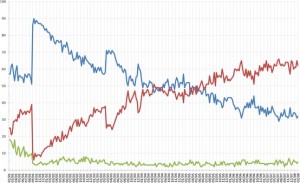David J. Hand recently authored a short, concise book about statistics, aptly named Statistics, and in it he attempts to bring forth an argument that statistics is a fascinating and very applicable science. I don’t argue with Hand in the slightest – I do find statistics very interesting, namely because I recognize its everyday uses. It is interesting enough, and if you have time and are keen on this sort of subject matter, then by all means go ahead and pick yourself up a copy.
My personal interest in the book aside, I would like to focus on a line of text at the beginning of Chapter 1. I’m sure most of us are familiar of the infamous Twain quote, “There are lies, damned lies, and statistics.” The musings of Twain that led to these words implied that statistics can be twisted, turned, mutilated, cooked, and subjected to other forms of mutation to get them to say what you want them to say. In short, many people have manipulated statistics to support a lie.
But perhaps we are less familiar with Frederick Mostellar, who once said “it is easy to lie with statistics, but easier to lie without them.” Mostellar was one of the most recognized statisticians of the 20th century – he helped found the statistics department at Harvard, was president of numerous professional organizations dealing with statistics, and was possibly one of the most dedicated teachers of statistics in the United States.
Being such an expert in the field, of course Mostellar recognized that statistics could be manipulated to get them to say what one wants them say. However, a statistic isn’t just a number we use to describe things; it is a representation of the world we live in. Underneath the surface of percentages or coefficients of determination is an entire world, built upon solid science and mathematical certainties. In this sense, statistics are a beautiful thing. We can use them to understand an otherwise complex, seemingly chaotic world – condense it down to numbers and figures that help to explain our surroundings.
Of course, there are those who have been burned by statistics. Most people, I’m sure, unknowingly. But let us not blame the statistic. After all, it’s hard to place blame on an inanimate representation such as a number. It doesn’t mean us any harm. The real fault should be placed on those people who use statistics for ill, those who manipulate the numbers for their own gain. Statistics in their purity are not contradictory – it’s those who use them that sometimes are. Of course, that can be applied to any discipline, not just statistics.
Undertaking research (and creating the subsequent statistics of findings) is certainly something not to be taken lightly. It requires dedication, motivation, and a clear goal to obtain truth. There will always be those who bend the numbers to either create a false truth or hide the real truth, but statistics should not be slighted or disregarded because of that. What the science should provoke is conversation and understanding in an effort to come to rational conclusions on how to move forward. As my own boss and mentor often says, statistics is perhaps one of the only sciences in which two different individuals studying them can come up with two different conclusions, and so long as they are not truly contradictory, both of them can be right. And that is the quintessential model of decision-making, using grounded results and findings to move an initiative forward.
Maybe you don’t agree with Hand’s (and to some degree my own) proposition that statistics is fascinating and cool and the most exciting of disciplines. But at the very least I hope you agree that statistics make the world around us better known, and thus more real.
If you would like to read Hand’s Statistics, here is the information:
Hand, David J. Statistics, Sterling Publishing Co., New York, 2010





